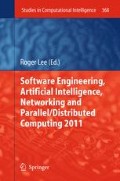Abstract
Offline handwritten recognition is an important automated process in pattern recognition and computer vision field. This paper presents an approach of polar coordinate-based handwritten recognition system involving Support Vector Machines (SVM) classification methodology to achieve high recognition performance. We provide comparison and evaluation for zoning feature extraction methods applied in Polar system. The recognition results we proposed were trained and tested by using SVM with a set of 650 handwritten character images. All the input images are segmented (isolated) handwritten characters. Compared with Cartesian based handwritten recognition system, the recognition rate is more stable and improved up to 86.63%.
Access this chapter
Tax calculation will be finalised at checkout
Purchases are for personal use only
Preview
Unable to display preview. Download preview PDF.
References
Liu, Z., Cai, J., Buse, R.: Handwriting recognition: soft computing and probabilistic approaches. Springer, Berlin (2003)
Deodhare, D., Suri, N.R., Amit, S.R.: Preprocessing and image enhancement algorithms for a form-based intelligent character recognition system. International Journal of Computer Science & Applications 2, 131–144 (2005)
Chandhuri, B.B.: Digital document processing: major direction and recent advances. Springer, London (2007)
Yan, C., Leedham, G.: Decompose-threshold approach to handwriting extraction in degraded historical document images, pp. 239–244. IEEE Computer Society, Los Alamitos (2004)
Nishida, H.: An approach to integration of off-line and on-line recognition of handwriting, pp. 1213–1219. Elsevier Science Inc., Amsterdam (1995)
Melin, P., Castillo, O., Ramirez, E.G., Janusz, K., Pedrycz, W.: Analysis and design of intelligent systems using soft conputing techniques. Springer, Berlin (2007)
Trier, D.O., Jain, K.A., Taxt, T.: Feature extraction methods for character recognition. Pattern Recognition 29, 641–662 (1996)
Pechwitz, M., Margner, V.: Baseline estimation for Arabic handwriting words. In: Proceedings Frontiers in Handwriting Recognition, pp. 479–484 (2002)
Simone, A.B.K., Cinthia, F.O.A.: Perceptual zoning for handwritten character recognition. In: Proceedings of 12th Conference of IGS, pp. 178–182 (2005)
Rajashekararadhya, S.V., Ranjan, P.V.: Efficient Zone Based Feature Extraction Algorithm for Handwritten Numeral Recognition of Rour Popular South Indian Script. Journal of Theoretical and Applied Information Technology, 1171–1181 (2005)
Majumdar, A., Chaudhuri, B.B.: Printed and handwritten bangla numeral recognition using multiple classifier outputs. In: Proceedings of the First IEEE ICSIP 2006, vol. 1, pp. 190–195 (2006)
Hanmandlu, M., Grover, J., Madasu, V.K.: Inout fuzzy for the recognition of handwritten Hindi numerals. In: International Conference on Informational Technology, pp. 208–213 (2007)
Vapnik, V.N.: The nature of statistical learning theory. Wiley, New York (1995)
Muller, K.R., Mika, S., Ratsh, G., Tsuda, K., Scholkopf, B.: An introduction to kernel-based learning algorithms. IEEE Trans. Neural Netw. 12(2), 181–201 (2001)
Camastra, F.: A SVM-based cursive character recognizer. Pattern Recognition Society 40, 3721–3727 (2007)
Hsu, C.W., Chang, C.C., Lin, C.J.: A Practical Guide to Support Vector Classification. Department of Computer Science. National Taiwan University (2003)
Kim, H., Pang, S., Je, H., Kim, D., Bang, S.Y.: Constructing support vector machine ensemble. Pattern Recognition 36, 2757–2767 (2003)
Dinesh, G.D.: Matlabcentral (December 2009), http://www.mathworks.com/matlabcentral/fileexchange/26158-hand-drawn-sample-images-of-english-characters
Nopsuwan chai, R.: Discriminative training method and their applications to handwriting recognition. Technical Report 652, University of Cambridge (2005)
Mpiperis, I., Malassiotis, S., Strintzis, M.G.: 3-D face recognition with the geodesic polar representation. IEEE Transaction on Information Forensics and Security, 537–547 (2007)
Blumenstein, M., Verma, B., Basli, H.: A Novel Feature Extraction Technique for the Recognition of Segmented Handwritten Characters. In: The 7th International Conference on Decument Analysis and Recognition (ICDAR 2003), pp. 137–141 (2003)
Author information
Authors and Affiliations
Editor information
Editors and Affiliations
Rights and permissions
Copyright information
© 2011 Springer-Verlag Berlin Heidelberg
About this paper
Cite this paper
Wang, X., Sajjanhar, A. (2011). Polar Transformation System for Offline Handwritten Character Recognition. In: Lee, R. (eds) Software Engineering, Artificial Intelligence, Networking and Parallel/Distributed Computing 2011. Studies in Computational Intelligence, vol 368. Springer, Berlin, Heidelberg. https://doi.org/10.1007/978-3-642-22288-7_2
Download citation
DOI: https://doi.org/10.1007/978-3-642-22288-7_2
Publisher Name: Springer, Berlin, Heidelberg
Print ISBN: 978-3-642-22287-0
Online ISBN: 978-3-642-22288-7
eBook Packages: EngineeringEngineering (R0)

